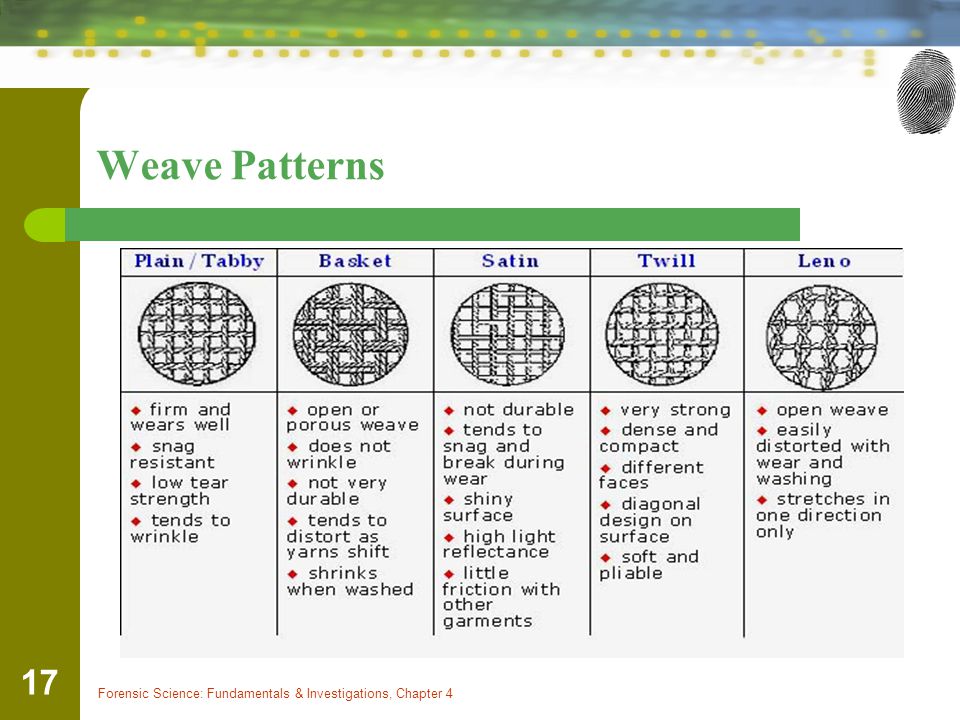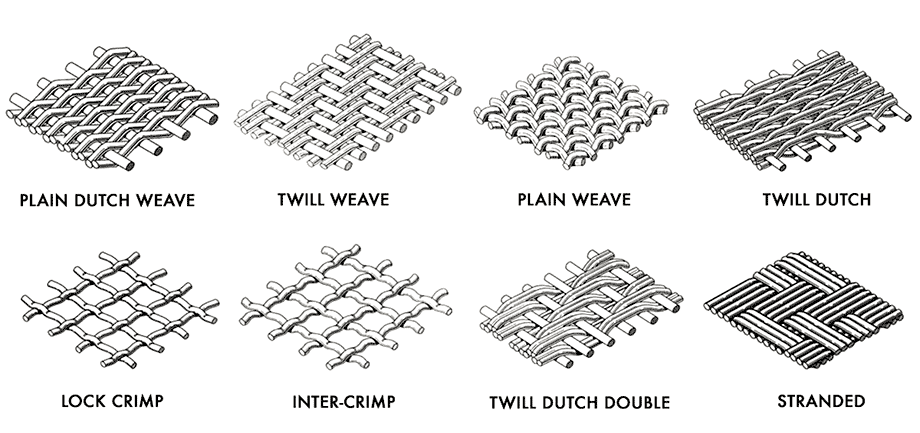Describe the Weave Patterns of Each of the Fabrics
Plain looks like a checkerboard. Satin is not uniform c 100 Nylon Rope.

Nine Types Of A Total 18 Samples Of Fabric Weave Patterns For Download Scientific Diagram
Each warp yarn passes alternately over and under each filling yarn.

. Jacquard is also the name used to describe the fabrics that can be created on a jacquard loom. This is a one-to-one overlap of Warp and Weft threads the Weft threads go over and then under the Warp threads. In the next row the pattern is shifted over one to.
Alternating pattern of two weft threads crossing two warp threads. Geometric and curvilinear forms in yellow blue. - does not wrinkle.
- tends to distort as yarns shift. Describe the weave patterns of each of the fabrics pictured below. Woven cloth can be plain or classic in one colour or a simple pattern or can be woven in decorative or artistic design.
The way the warp and filling threads interlace with each other is called the weave. Twill weave consists of parallel ribs woven in a diagonal pattern. The number of threads that are.
The majority of woven products are created with one of three basic weaves. This fabric looks the same on both sides and is the cheapest to make. There are different types of weave for the production of fabrics such as.
Twill because its diagonal. A plain weave is the most simple and most commonly used weave pattern. Properties of Satin Weave.
The majority of the fabrics we use on Sew4Home fall into the Plain Weave category including the quilting cottons we all love. Below is a list of the different kinds of the fabrics discussed in details. Describe the weave patterns of each of the fabrics pictured below.
In this case we use smoothness and connectivity to describe and classify these irregular patterns. The smoothness is measured by the horizontal vertical and diagonal transitions and the connectivity is measured by the number of black warp point nominal value equals 1 and white weft point. Weave patterns have names like tabby twill and satin.
Plain weave satin weave or twill weave. A plain weave is the most basic type of weaving. Satin weave gives a fabric high luster an elegant look and a luxurious feel.
Examples of plain weave fabrics are calico taffeta Habutai silk viole cotton shirting and muslin. As a traditional woven a basketweave fabric can introduce warmth to a room to balance out more neutral and subdued tones says Ella Hall founder of Stitchroom. The simplest of all weaves is the plain weave.
This has some categories as follows. The Mandaya people of Davao Oriental are known for their masterful ikat a weaving pattern in abaca the primary fiber they use for weaving. Satin fabric is one of the most popular and stylish fabrics and has a high durability value.
Leno The leno weave is a locking type weave in which two or more warp threads cross over each other and interlace with one or more filling threads. Each filling yarn passes alternately over and under one warp yarn. Basket- alternative pattern of two weft threads crossing two wrap threads Twill- weft is woven over three or more warps and then under one.
Describe the weave patterns of each of the fabrics pictured below. Satin fabrics are relatively high maintenance. This fabric is commonly used to wipe glassware and therefore it is sometimes known as a glass toweling.
The fabric can be very light and airy without sacrificing stability. It is strong and hard-wearing and is used for fashion and furnishing fabrics. Plain weave also called tabby weave linen weave or taffeta weave is the most basic of three fundamental types of textile weaves along with satin weave and twill.
There is a broad range of different types of linen fabrics which can be identified from each other by the weave patterns and the texture. Plain weave is the simplest and tightest weave. One weft over three or more warp.
Twill cause its diagonal d 100 Spandex Nylon. By controlling each end in the warp. Designed to resemble the crisscross weave of a basket basketweave patterns are either woven or printed onto a fabric to create a symmetrical effect.
The simplest weave pattern is the plain or tabby weave. Each horizontal weft thread is interlaced with each vertical warp thread by going over the first and under the second over the third and so on. Pile CutUncut Double Cloth.
The most basic fabric construction is called go figure the Plain Weave. When used correctly the handmade texture is a. - an open or porous weave.
The weft yarn goes over and under alternate warp yarns. - not very durable. In this type of weave the warp and filling threads cross alternately.
Some examples of plain-weave fabric are crepe taffeta organdy and muslin. The weft travels left to right and is woven between the two wrap threads. Plain woven fabrics are generally the least pliable but they are also the most stable.
The closer the yarns the denser the fabric. Justify your answer for each a 100 Cotton. Ribbed Warp.
In plain weave cloth the warp and weft threads cross at right angles aligned so they form a simple criss-cross pattern. 100 Spandex Nylon i. In 1804 Joseph Marie Jacquard invented the device that attaches to a power loom that simplifies the process of weaving complex patterns such as frames large geometrics florals etc.
Variation of Basic weave. One of their most popular textiles is called dagmay a handwoven cloth designed with patterns of man and crocodile for which the Mandaya weavers are known for. Twill because it s diagonal.
- shrinks when washed. Satin and Sateen weave. Because of such rigorous interlacing the plain weave is the most solid construction.
For many fabric weave patterns the step in warp or weft is not a fixed number.

Textile Basic Weaves Britannica

Identify And Describe Common Weave Patterns Of Textile Samples Ppt Video Online Download

A Guide To Wire Cloth Weaves Types Of Weaves More Newark Wire
No comments for "Describe the Weave Patterns of Each of the Fabrics"
Post a Comment